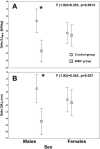Sex-specific response to whole-body vibration training: a randomized controlled trial
- PMID: 35173379
- PMCID: PMC8805365
- DOI: 10.5114/biolsport.2021.102806
Sex-specific response to whole-body vibration training: a randomized controlled trial
Abstract
A few studies have indicated that males and females respond differently to whole-body vibration (WBV) training. However, the existing insights are still insufficient and they cannot be transferred to sex-specific practice planning. To evaluate the effect of 5-week WBV training on neuromuscular [countermovement jump (CMJ), squat jump (SJ)] and cardiovascular [heart rate and blood pressure] data, taking into account sex-specific effects. This is a comparative experimental study including 96 healthy adults, divided into two groups: a WBV group (25 females and 24 males) and a control group (27 females and 20 males). The participants attended nine to ten training sessions (twice a week for 5 weeks), each lasting approximately 30 min. Both groups performed the same exercise routine on the vibration training device. For the WBV group, the training device was vibrating during the whole training session, including the breaks. For the control group, it was turned off. Maximum jump height (H, cm) and maximum relative power (MRP, kW/kg) were noted during CMJ and SJ performed on a force plate. Resting (sitting) heart rate (bpm) and blood pressure (mmHg) were measured twice, before and after the intervention. For each parameter, Δdata (= before - after) was calculated. Interactive effects of sex (2) vs group (2) vs session (2) were noted only in males and they only concerned ΔSJMPR and ΔCMJH: compared to the control group, the WBV group had better ΔSJMPR (1.39 ± 3.05 vs -2.69 ± 4.49 kW/kg, respectively) and ΔCMJH (0.50 ± 6.14 vs -4.42 ± 5.80 cm, respectively). No sex-specific effect of WBV on neuromuscular (CMJ and SJ) or cardiovascular (heart rate and blood pressure) data was found.
Keywords: Cardiovascular effects; Gender; Germany; Jumping performances; Oscillatory activity; Recovery; Training.
Copyright © Biology of Sport 2021.
Conflict of interest statement
Helmi BEN SAAD reports personal fees from AstraZeneca, Opalia Recordati and Chiesi. The remaining authors declare that they have no conflicts of interest concerning this article. Appendix for this article is available online (link).
Figures



References
-
- Hausswirth C, Bieuzen F, Barbiche E, Brisswalter J. Physiological responses after a cold-water immersion and a whole-body cryostimulation:Effects on recovery after a muscular exercise. Sci Sports. 2010;25(3):121–131.
-
- Swartzendruber K. The importance of rest and recovery for athletes. Michigan State University Extension; 2013.
LinkOut - more resources
Full Text Sources
